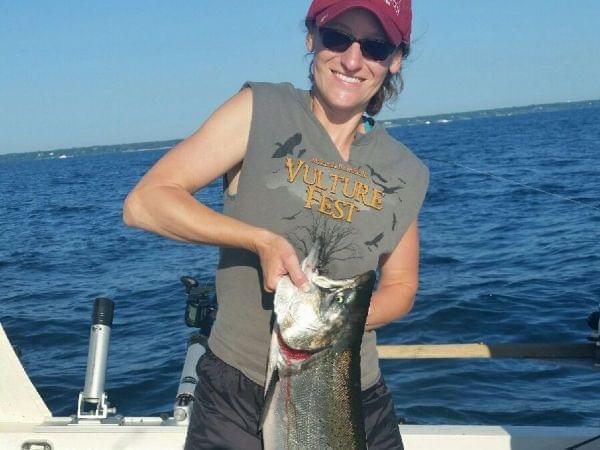Time to sever artificial connection between Great Lakes, Mississippi Basin [from the archive]

Recreational angler Carol Sabaj of Champaign with a 14lb Chinook salmon caught in July on Lake Michigan out of Waukegan Harbor, Waukegan IL. The multimillion dollar recreational and commercial industries currently supported by the Great Lakes could be devastated by the invasion of Asian carp. Robert Holthusen
It's ironic that the Prairie State is bordered by two of the world’s most extensive aquatic systems. On the northeast we’ve got Lake Michigan, the fifth largest lake in the world and our connection to the rest of the Great Lakes system and by extension the Atlantic Ocean. On the west, we’re bordered by the Mississippi River, which, with all of its tributaries, drains nearly half of the continental United States. Indeed, except for a tiny sliver of Lake Michigan shoreline, the whole of Illinois lies within the Mississippi drainage, since all of the other waters that flow from the state wind up in the Big Muddy.
Prior to the year 1900, these two colossal systems were nowhere directly connected. They came very close to one another in an area of what is now the southwest suburbs of Chicago. There, the upper Des Plaines River, which is part of the Mississippi drainage, and the West Branch of the Chicago River, which then flowed into Lake Michigan, were separated only by a slim drainage divide, known as the Chicago Portage. But because there was this land divide, however narrow, fish and other aquatic organisms were unable to easily pass back and forth between the Great Lakes and the Mississippi River systems.
The land barrier between the two systems was breached in 1900 by completion of the Chicago Sanitary and Ship Canal, which famously reversed the flow of the Chicago River and enabled the City to flush its waste into the Mississippi basin rather than Lake Michigan. The extensive Chicago Waterway System still serves that function. In addition, it supports significant recreational boating and commercial shipping.
These functions notwithstanding, hindsight allows us to see that connecting the Mississippi Basin with the Great Lakes system so directly was not a good idea, either from an ecological or a financial perspective. That’s because doing so enables aquatic invasive species to move between them.
To date, the most notorious invaders to make the passage from Lake Michigan into the Mississippi basin have been two small but prolific organisms, a fish called the round goby, and the better-known zebra mussel. Both of these creatures cause irreparable harm to ecosystems where they are introduced, and control measures for zebra mussels alone cost millions of dollars annually.
Two species of invasive fish moving in the other direction—from the Mississippi toward the Great Lakes—have caused even greater concern in recent years. Of these, silver carp are the ones you’re most likely familiar with—they can weigh up to 60 pounds and they leap high out of the water when they’re disturbed by boats. Beyond the fact that these guys can wreck a day on the water for boaters, they wreck the ecology of waters they invade and, in the process, wreck tourist and commercial fishing industries.
Since the threat posed by Asian carp was first recognized more than a decade ago, various schemes have been cooked up to keep them out of the Great Lakes, including the electric barriers that are now in place. But it’s doubtful any such measures can do the job over the long run, and already adult fish have been found beyond the barriers twice.
Ultimately, the best way to keep Asian carp out of the Great Lakes would be to do reestablish a land divide between them and the Mississippi Basin. Such a divide would have the added benefit of preventing the spread of all nuisance species in both directions.

